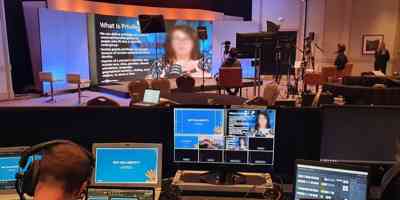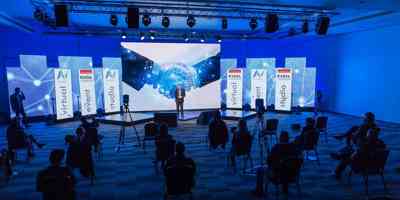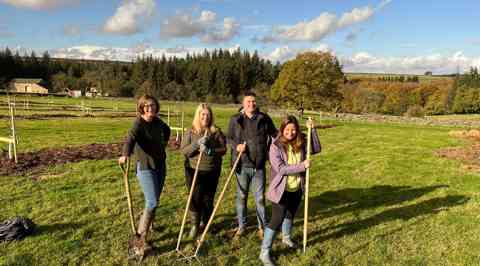So, what is a hybrid meeting? There is a lot of talk about them, not least in a post-Covid-19 world, and they are widely being hailed as the future of our industry.
One of the idiosyncrasies of the situation we’ve all found ourselves in, is that it seems to have spawned a whole raft of ‘words-de-jour’, and we’re all getting used to a barrage of buzz phrases. Tick them off; unprecedented, new normal, pivot to digital, disruption. Here in events world, one of the big ones must be ‘hybrid’.
So, what is a hybrid meeting? There is a lot of talk about them, not least in a post-Covid-19 world, and they are widely being hailed as the future of our industry. But, what does one look like, how do you organise one, and where does it fit in with the wider world of meetings and events?
So, the following is the Lime Venue Portfolio take on hybrid meetings, put together with a little help from our learned friends.
An Event
Let’s start things simple, the general make-up of an average event is fairly basic and has been for some time. People congregate in numbers, according to the meetings industry association this would be a minimum of 20 people, and an average or around 100, if we are talking about official, produced, ‘meetings and events’ not just the millions of smaller internal / board meetings that happen every week. The average length of this meeting, again according to the mia, will be around a day and a bit – varying from a three to four-day retreat, to a simple one day or half day meeting, conference or training programme.
The format is usually fairly basic, people turn up, they have a morning session, eat lunch, they come back in the afternoon for more sessions, then depart. In and amongst these meetings will be a mixture of main plenary sessions, breakout sessions, workshops and time for networking during breaks, lunches and dinners.
Regardless of the quality or vibrancy of the content, the beauty of the surroundings, the critical nature of the meeting, pretty much most meetings have taken on this standard format.
A Digital Event
Digital events are not new. For over thirty years now, businesses have looked to reduce the travel time and expense of one-to-one or even smaller group meetings. The emergence of digital technology has given them myriad of options to do so; honestly speaking, most of these have been pretty useless. In fact, it’s only really now that we are really getting the hang of Zoom, Google Hangout, Go-to-Meeting, Microsoft Teams, and the many other platforms, and it took a massive global pandemic to do so. Equally, these platforms are only showing their value on a one to one meeting basis, it still gets pretty difficult if numbers pass four or five.
In the meantime, the meetings industry has continued to flirt with taking mass meetings online completely. Hosting them in virtual spaces, delivering content direct to the laptop, tablet or phone of the delegate, regardless of where they sit.
Unlike the smaller meeting technologies, this format is really gathering pace. The production quality of these events is getting better and better and the experience of the digital delegate is improving, and the value to them is growing with it. These events are significant and important, not least during the global shut down. This technology has allowed crucial meetings to take place, regardless of the lack of physical communal meeting place, be it task forces to fight the virus itself or deliver messages to large amounts of people to keep them informed, safe or just connected. In the past an event would simply have been cancelled, communication slowed to frustratingly unproductive levels, and productivity compromised. Now, they can happen, and they work.
However, the general consensus of the meetings and events industry is that they aren’t the complete solution, just part of it. People still want to meet, they want to interact, and there is a basic human need to be social, to congregate, to share and to be spontaneous in interactions. Things that even the very best technology just can’t give us. Still, the digital experience is too good, too big, to ignore.
A Hybrid Event
In its simplest form, the hybrid event is a mixture of both of the above – a hybrid. It combines all the aspects of a traditional event, but uses technology to enhance it, to augment it, and to widen its reach and longevity.
Essentially it means the event organiser is building two events, around the same content, but allowing multiple physical and virtual cross overs. Digitisation of events means that audiences can engage with speakers or pick up information from sponsors or partners, on their phones. This is as easily done in the room as it is on the other side of the world. At the same time, guests at the live event can watch a speaker session on their tablet whilst grabbing a coffee next door, they can zone in and out of the event according to their needs. Its flexibility within an event on the same scale as the bedroom delegate.
Production of a hybrid event is usually heightened; people are used to watching movies, TV and Netflix on their tablets, they are used to a high level of production quality and anything else being streamed onto the device needs to aspire to get near this level. This changes the experience in the room; more drama, lighting, direction and imaginative sets.
The digital event is also excellent at pre event communication. Because interaction is limited on the day, digital events have led the way in pre event interaction and engagement. Delegates can watch advanced content, question speakers and input into the programming before it has even begun. The event is lengthened, but also massively enriched in a way that cannot be done live, no matter the duration of the event. This is great news for the live event attendee as well, they come armed and ready and are already part of a hybrid experience.
Meanwhile, we have the event technology sector bringing these two different experiences closer together; augmented reality allows the delegate to add on a digital layer to their live experience using their phones or tablets. Attendees can see details of the speaker labelled onto the screen, or even information on fellow delegates. Registration is by either facial recognition or by the swish of a smart watch. In the same way as the ‘out-of-room’ delegate is having their event digitised, so too is the live audience.
How about the event organiser?
Hybrid events are demanding on the event organiser. They have to create an experience for those attending and those not attending that has the same message and culture, but still works despite the obvious geographic restrictions. They are creating one event for the live audience, each of whom will want to personalise their day, and another event for hundreds of others, all consuming the content in locations from bedrooms to beaches.
In the meantime, they need to make sure technology is right at either end of the broadcast; within the live event venue and on the other end of the laptop. At the same time as they look to manage audience flow and movement around a venue, they will need to look after the particular demands of a globalised audience, each with a different agenda, and each expecting to be equally part of the experience.
Venues can be a massive support here. In the past a venues remit has been about atmosphere, layouts, comforts, technology and food. Now the venue is a hub, which needs to reach often thousands, sometimes hundreds of thousands of people. At the same time, it needs to be film set, broadcasting house, and offer an amazing food experience. This is fine, venues have evolved, they are changing all the time to meet the needs of an increasingly pressurised event planner and offering ready-made solutions that take the pain away.
So, where does this all lead?
At Lime Venue Portfolio, we’re proud of our self-appointed moniker as the cheerleader for great events. Even though we’re all about venues, real things, and real food, this doesn’t mean we are against digital events; if there is one thing this shut down has taught us, it’s that events have to happen, and if that means digital then we advocate for the highest possible quality.
At the same time though, the second thing this shut down has taught us is the importance of being face to face, not just for business, but for life. That’s why we believe in the hybrid meeting, a cross that embraces every kind of delegate in every geography and allows them to have an amazing experience. It’s a good thing.
So, where does this all lead? In the last 10 weeks, it seems the rate of evolution has expanded exponentially to the point where we are seeing digital and hybrid events being produced on a quality we wouldn’t be expecting for another few years. One of the big changes though is the strategic thinking behind the creation of hybrid events. This thinking is spawning new ideas that can only be good for the events industry. We previously shared an interview with the Live Group and their model for ‘digital twinning’ a way of producing hybrid events in a truly modern way. It’s this kind of thinking that will continue to drive the pace of change.
What can be said is that this focus on hybrid solutions has forced us all; venues, organisers, delegates and event suppliers to think differently, to think beyond the standard event format that has been the go-to since events began. This can only be a good thing. To quote Albert Enstein; ‘If You Always Do What You Always Did, You Will Always Get What You Always Got.’





